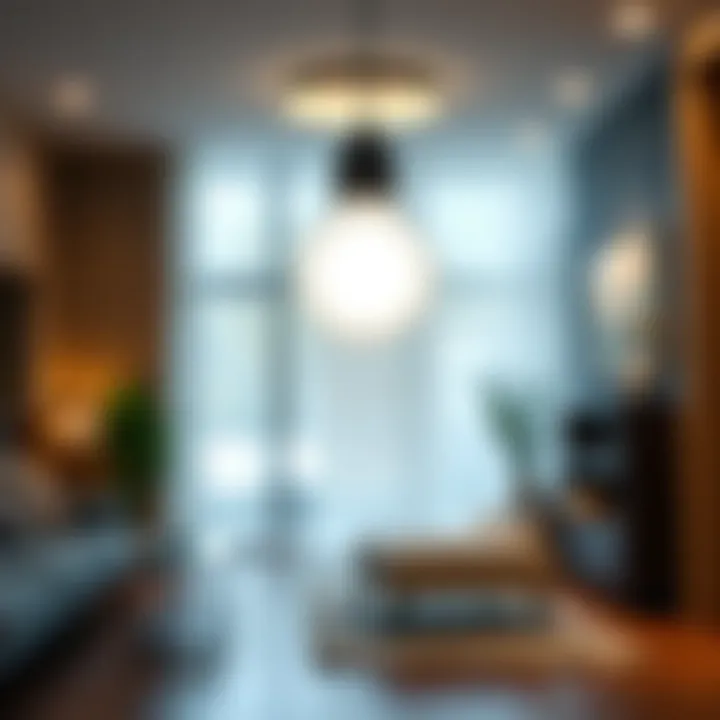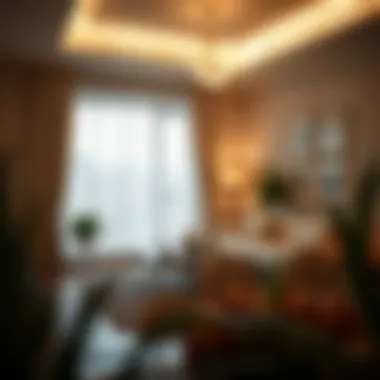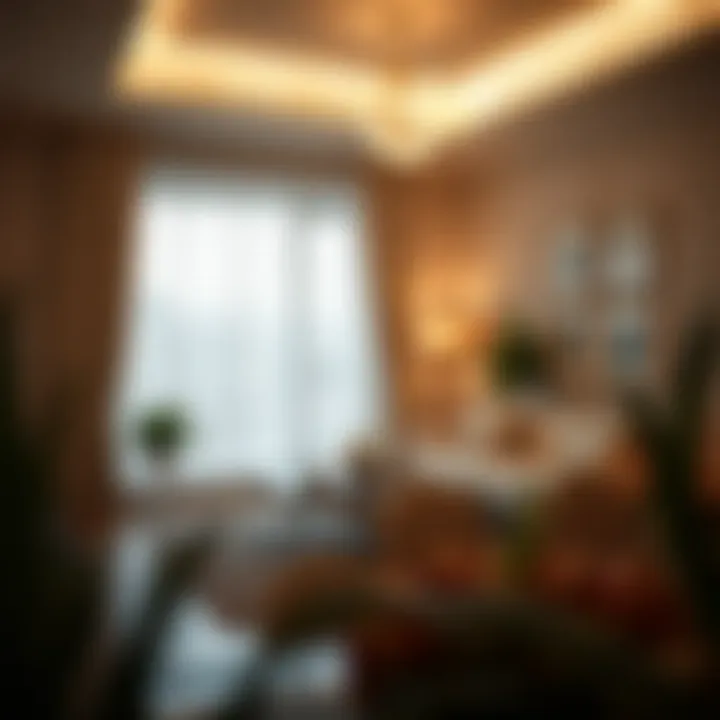Efficiency and Versatility of 100 Watt LED Bulbs


Intro
In a world where energy efficiency and aesthetics go hand in hand, 100 watt LED light bulbs have emerged as a formidable solution. Beyond just illuminating spaces, these bulbs redefine how we perceive and enjoy our environments. Homeowners and professionals alike are increasingly recognizing their value—not only for lighting but for enhancing the overall design aesthetic of a room.
LED technology has transcended its initial reputation of merely being energy-efficient. Today, it boasts an extensive range of designs and applications that cater to diverse personal tastes and functional needs. From cozy living rooms adorned with elegant fixtures to modern offices requiring optimal productivity lighting, the versatility of 100 watt LED bulbs becomes apparent.
This section aims to navigate through the critical aspects of utilizing 100 watt LED bulbs in various settings. Several factors make them deserving of your consideration, such as energy savings, longevity, and their overall impact on interior design. Each of these facets provides insights necessary for making informed choices about lighting in both residential and commercial spaces. So, let’s dive into the underlying trends in furniture styles that merge seamlessly with these innovative lighting solutions.
Understanding LED Technology
Understanding LED technology is fundamental to grasping the full potential of 100 watt LED light bulbs. This section lays the groundwork for the rest of the article, enhancing readers’ comprehension of how LED lights function and their relevance in modern lighting solutions. It is crucial for homeowners, designers, and DIY enthusiasts to familiarize themselves with these key points to make informed choices about lighting in their spaces.
What Are LED Bulbs?
LED bulbs, or Light Emitting Diodes, represent a significant shift in the way we illuminate our environments. Unlike traditional incandescent bulbs that use filaments to produce light, LED bulbs generate light through electroluminescence. This process involves electrons moving through a semiconductor material, which emits light as a result.
There are several types of LED bulbs available, each with various applications and benefits. For instance, many LED options are designed to mimic the warm glow of incandescent lights, making them suitable for cozy spaces like living rooms and bedrooms. Meanwhile, others offer brighter, more direct light for functional areas such as kitchens or offices. The ability to choose the right type of LED bulb can greatly affect the ambiance and utility of a room.
The Science Behind LED Lighting
The science of LED lighting delves deeply into the principles of physics and engineering. LEDs operate on the principle of quantum electrodynamics, where photons are emitted through electron transitions in semiconductor materials. This intricate process excels in energy efficiency compared to conventional bulbs; they waste little energy as heat, leading to lower electricity consumption.
Additionally, LED technology has advanced significantly, resulting in bulbs that not only meet energy efficiency standards but also offer a longer lifespan. A typical LED bulb can last anywhere from 15,000 to 50,000 hours, far outstripping its incandescent counterpart. This longevity means fewer replacements, translating into cost savings over time.
Comparing LED to Traditional Bulbs
When pitting LED bulbs against traditional lighting options, the difference in efficiency and effectiveness is stark.
- Energy Consumption: LED bulbs use significantly less wattage compared to incandescent and fluorescent bulbs. A 100 watt LED typically produces the same brightness as a 1000 watt incandescent bulb.
- Lifespan: LEDs last longer, reducing the frequency of replacement and minimizing waste.
- Heat Generation: LEDs emit very little heat, making them safer and more energy-efficient.
- Environmental Impact: With a longer lifespan and reduced energy use, LED bulbs contribute less to pollution and waste, aligning closely with sustainable practices.
"Switching to LED lighting can decrease your energy bill significantly while also reducing your carbon footprint."
In essence, understanding LED technology is not just about knowing how these bulbs work; it’s about recognizing their broader impact on personal finances and the environment. This foundational knowledge sets the stage for exploring the specific characteristics and advantages of 100 watt LED bulbs later in this article.
Essential Characteristics of Watt LED Bulbs
Understanding the essential characteristics of 100 watt LED bulbs is pivotal when considering them for various lighting applications. These bulbs stand out not just for their light output but also for their energy consumption and longevity. When tackling a lighting project, whether you're enhancing a room in your home or designing a commercial space, grasping these characteristics will surely lead to informed decisions.
Brightness and Lumens Explained
Brightness, measured in lumens, is a critical attribute of any light bulb. For a 100 watt LED bulb, the typical lumen output hovers around 1,600 to 2,200 lumens. This range provides ample light for most scenarios, surpassing traditional bulbs that require more energy to achieve comparable brightness.
To put it simply, lumens tell you how much light a bulb emits. If you’re lighting up a living room for a cozy atmosphere, you'd want a bulb that emits a warm glow. Conversely, for task lighting in a workshop, a brighter option may suit your needs better. When selecting LED bulbs, consider the context in which they will be used. 100 watt LED bulbs serve well in a variety of situations, thanks to their superior lumen output and efficiency.
Energy Efficiency Ratings
One of the most significant attributes of LED technology is its energy efficiency. 100 watt LED bulbs are designed to utilize about 80-90% less energy compared to their incandescent counterparts. This remarkable efficiency is represented through Energy Star ratings and other efficiency labels which signify compliance with energy standards.
For instance, a typical 100 watt incandescent bulb uses about 100 watts to produce light, whereas a 100 watt LED bulb might only require around 15 to 25 watts for the same amount of lumens. This discrepancy means savings on electricity bills and a reduction in your carbon footprint—an essential consideration for environmentally-conscious consumers.
By switching to energy-efficient lighting, families can save significantly over the lifespan of the bulbs while decreasing their environmental impact.
Lifespan and Durability
Another attractive characteristic of 100 watt LED bulbs is their impressive lifespan. Standard LED bulbs can last up to 25,000 hours, which surpasses conventional bulbs that tend to flicker out after just 1,000 hours or so. The durability of LED technology stems from its solid-state construction, which is more resilient to shocks, vibrations, and the elements than traditional bulbs. This longevity not only translates to less frequent replacements but also less waste.
When investing in lighting, think about the long-term implications. The reduced maintenance and replacement costs associated with 100 watt LED bulbs make them a smart choice for both residential and commercial uses. In areas where changing a light bulb is a hassle, such as high ceilings or inaccessible spots, the longevity of these bulbs shines even brighter.
Advantages of Using Watt LED Bulbs


The advantages of using 100 watt LED bulbs are not just beneficial for lighting up your rooms but also extend to financial, environmental, and practical aspects that make them a smart choice. Homeowners, designers, and even decorators are beginning to see how these bulbs can be a game changer in various lighting scenarios. Let’s break down some key points that illustrate their significance.
Cost Savings Over Time
When it comes to budgeting, no one wants to throw away hard-earned cash. Using 100 watt LED bulbs can save you a pretty penny over time. While the initial outlay might be higher compared to traditional incandescent bulbs, the long life and efficiency of LEDs quickly make up for it.
- Lower Electricity Bills: LED bulbs use significantly less energy compared to incandescent or halogen options. For example, a 100 watt LED bulb typically consumes around 15-20 watts of power and can last for around 25,000 hours. Imagine the savings when you keep your lights on for late-night study sessions or weekend movie marathons!
- Reduced Replacement Costs: With a lifespan of around 25 times longer than traditional bulbs, you’ll spend less on replacements. No more running to the store every few months to keep your indoor spaces illuminated. This not only saves money but also time and effort.
- Energy Tax Credits: In some regions, using energy-efficient lighting can qualify homeowners for tax credits. It's worth checking local regulations to see if you can snag some extra savings.
Environmental Benefits
The environmental impact of lighting shouldn’t be overlooked. Choosing 100 watt LED bulbs is a straightforward way to contribute to a happier planet.
- Lower Carbon Footprint: Since LEDs consume less energy, they help in reducing your overall carbon footprint. Think of it this way—every little bit counts toward fighting climate change.
- Less Waste: Their long lifespan means less frequent disposal, directly cutting down on waste. Traditional bulbs often end up in landfills after just a short period; with LEDs, you're making a choice that minimizes landfill contributions.
- Toxic Material Reduction: Unlike some other types of bulbs, LED lights don’t contain hazardous materials like mercury, making them a safer choice for the environment as well as for households, especially those with kids.
"An energy-efficient lifestyle isn’t just a trend; it’s a commitment towards future generations."
Versatility in Usage
The unique versatility of 100 watt LED bulbs makes them ideal for a multitude of scenarios.
- Various Applications: These bulbs can effortlessly fit into numerous settings—from cooking in the kitchen to mood lighting in the living room. Their ability to deliver bright illumination or soft ambient light depends on your needs.
- Different Color Temperatures: Whether you desire a cozy warm glow or bright daylight clarity, 100 watt LED bulbs can be found in a variety of color temperatures to match any mood or decor. This adaptability allows designers and decorators to create stunning atmospheres tailored to specific spaces.
- Smart Options: Many 100 watt LED bulbs now come equipped with smart technology, enabling control via smartphones or voice. Imagine dimming the lights without leaving your seat! Such integration can enhance home automation significantly, appealing to tech-savvy users and simplifying daily life.
In essence, the advantages of 100 watt LED bulbs extend beyond basic lighting needs, providing compelling financial, environmental, and practical benefits that cater to both typical homeowners and design professionals alike.
Design Variations of Watt LED Bulbs
The design of 100 watt LED bulbs plays a crucial role in their functionality, aesthetics, and versatility, making it an essential topic for discussion. As more homeowners and designers explore innovative lighting options, understanding the various design aspects of these bulbs can inform decisions that blend form and function. With advancements in technology, LED bulbs are available in multiple shapes, sizes, and features, adapting to diverse needs and preferences. Here, we will delve deeper into three significant aspects:
Different Shapes and Sizes
When it comes to lighting fixtures, one size or shape does not fit all. The myriad shapes and sizes available for 100 watt LED bulbs can greatly influence the atmosphere of a room. Bulbs typically come in standard A19 shapes for typical fixtures, while others may mimic traditional styles like globe or candle shapes.
- Aesthetic Appeal: Shapes such as vintage Edison bulbs with exposed filaments cater to those wanting a nostalgic touch, while sleek, modern designs fit better in contemporary settings.
- Functionality: Bulbs designed for directional lighting, such as PAR (Parabolic Aluminized Reflector) bulbs, excel in task lighting, whereas soft white bulbs offer a more diffused light ideal for ambient settings.
- Compatibility: Different designs can enhance compatibility with fixtures, affecting how light is dispersed. For instance, a longer bulb may be more suited for recessed lighting, while compact designs can fit into smaller table lamps.
In considering the right shape or size, it becomes essential to evaluate not only the practical aspects but also how these designs can affect the overall look of your space.
Color Temperature Options
The color temperature of a light can significantly alter the perception of a space. Measured in Kelvin (K), this attribute can evoke various moods or functions within an environment. Here are common ranges you might encounter:
- Soft White (2700K to 3000K): This warm glow captures the essence of traditional incandescent bulbs, making it an excellent choice for cozy living areas and bedrooms.
- Bright White (3000K to 4000K): Ideal for task-oriented spaces, such as kitchens and bathrooms, where clarity is needed for activities like cooking or grooming.
- Cool White (5000K to 6500K): Best suited for commercial settings or spaces needing high alertness, such as offices, providing a bright environment that mimics daylight.
Understanding these options allows homeowners and designers to play with light to either enhance natural appearances or create specific ambiances, aligning the light with the intended use of the space.
Smart LED Options
As technology evolves, the introduction of smart LED bulbs has provided a wealth of new opportunities. Smart 100 watt LED options come equipped with features that offer both convenience and customization:
- Remote Control: Users can adjust brightness and color from their smartphones or tablets, creating personalized lighting scenes fitting various times of day.
- Integration with Smart Home Systems: Compatibility with platforms like Amazon Alexa or Google Home allows for voice-activated controls, automating sequences based on daily routines.
- Energy Monitoring: Some smart bulbs come with app functionalities that track energy usage over time, enabling users to identify potential savings by adjusting usage patterns.
Smart options broaden the potential applications of 100 watt LED bulbs, making them not just a lighting solution but part of the broader technological landscape of modern living.
"Lighting can transform a space, but its design variations can elevate that transformation to new heights."
Ultimately, recognizing the design variations available in 100 watt LED bulbs assists users in selecting the right fit for their unique circumstances while enhancing the room’s form and function.
Applications of Watt LED Bulbs
The widespread adoption of 100 watt LED bulbs has transformed how we approach lighting in various settings. As we navigate further into the age of energy efficiency, understanding where and how to use these bulbs effectively becomes paramount for anyone looking to enhance their living or working environment.
Indoor Lighting Solutions


When we talk about indoor lighting, it involves much more than just flicking a switch. The ambiance, functionality, and aesthetic of a space are significantly affected by the choice of lighting. 100 watt LED bulbs present an excellent solution, delivering a bright lumens output while consuming less energy compared to traditional incandescent bulbs. This is not just a convenience; it’s a smart investment.
Here are some noteworthy benefits of using watt LED bulbs indoors:
- Enhances Visibility: In spaces like kitchens and workrooms, the bright, clear light of these LEDs makes tasks easier and safer.
- Diverse Fixture Compatibility: Their design allows for easy integration into chandeliers, floor lamps, and sconces, making them a versatile choice.
- Reduced Heat Emission: Unlike incandescent bulbs, they don’t radiate excessive heat, making them safer, especially in crowded or confined spaces.
In essence, 100 watt LED bulbs can significantly improve the usability of every corner of your home.
Outdoor Lighting Uses
When it comes to outdoor lighting, efficiency and durability are crucial. 100 watt LED bulbs shine in this arena as well, providing reliable illumination for a variety of applications. Think driveways, gardens, and patios. They not only improve visibility but also enhance security around your property.
Key advantages include:
- Long-Lasting Performance: LEDs have a lifespan that can reach up to 25,000 hours, enduring harsh environmental conditions better than other bulb types.
- Energy Savings: With reduced electricity consumption, you can light up your outdoor areas without worrying much about your energy bill.
- Aesthetic Appeal: Available in various color temperatures, they can help create a warm, inviting atmosphere for evening gatherings.
This combination of functionality and curb appeal makes 100 watt LED bulbs a favorite choice for outdoor fixtures.
Specialty and Task Lighting
Specialty and task lighting require more than just mere brightness; they need to be precise, reliable, and adaptable. Whether you are focusing on art pieces, reading nooks, or hobby areas, 100 watt LED bulbs can cater to these specific requirements superbly.
Consider the following benefits:
- Focused Illuminate: The ability to direct light where needed allows for better visibility, crucial in task-related environments.
- Color Rendering: LED bulbs are known for their excellent color rendering index (CRI), helping maintain the true colors of art, fabrics, or food, which can be vital in design and culinary settings.
- Dimmer Compatibility: Many 100 watt LED options can work with dimmer switches, allowing for mood adjustments as required.
Your lighting doesn't have to be a one-size-fits-all; with 100 watt LED bulbs, it becomes as personalized and intentional as you’d like.
Installation and Usage Recommendations
When considering 100 watt LED light bulbs, one must pay close attention to installation and usage recommendations. Getting the installation right is crucial not just for optimal performance, but also for maximizing energy efficiency and bulb longevity. The correct setup minimizes the risks of overheating or failed connections, which in turn protects your investment in lighting. It's about setting the stage for these bulbs to shine their brightest and serve their purpose effectively.
Proper Installation Techniques
Installing LED bulbs correctly is paramount. Unlike their incandescent counterparts, LEDs are sensitive to certain conditions. Here are some essential techniques to keep in mind:
- Check the Fixture Compatibility: Not all light fixtures are compatible with LED bulbs. Always check if your fixture can handle the wattage and if it supports an LED installation.
- Use Appropriate Wattage: Ensure that the LED bulb's wattage matches or is lower than the recommended wattage for the fixture. For instance, replacing a traditional 100 watt bulb with a 100 watt LED is safe, but using any bulb rated higher could lead to problems.
- Installation Position: Make sure the bulb is installed securely in its socket. A loose fit can lead to flickering lights or failure to turn on altogether. Turning the bulb snugly without excessive force will ensure a secure connection.
"Proper installation can prevent premature failure of LED bulbs, ensuring they last as long as they should."
Proper installation is not just about ensuring functionality; it contributes to the safety and performance of the lighting system.
Optimal Placement and Arrangement
After ensuring proper installation, it's time to focus on the placement and arrangement of your 100 watt LED bulbs. The strategic placement of lights can significantly influence the ambiance and functionality of any space. Consider the following:
- Height Matters: Mount fixtures at appropriate heights. For instance, in a living room, positioning LED bulbs to provide general illumination should be around 8 to 10 feet high, while task lighting for reading might benefit from lower placements.
- Layered Lighting: Combining ambient, task, and accent lighting is essential. This triad can enhance your room's dimension. Use 100 watt LEDs for general lighting and complement them with lower wattage bulbs for accent features.
- Consider Light Direction: Opting for adjustable fixtures can allow for better control over light direction. Aim your 100 watt LEDs downwards to illuminate work surfaces or upwards to create an ambient glow.
Maintenance and Care for Longevity
The life expectancy of a 100 watt LED bulb can stretch out to 25,000 hours or more if properly maintained. Here are ways to extend their lifespan:
- Regular Dusting: Dust buildup can trap heat. Keep bulbs clean and free from dust by gently wiping them with a dry cloth.
- Monitor for Flickering: If bulbs flicker, it might indicate an electrical issue or compatibility problem. Address it promptly to avoid further damage.
- Don’t Overheat: If you notice that the bulbs feel unusually hot, ensure there is enough ventilation around the fixture. Overheating can drastically shorten their life span.
Caring for your bulbs not only helps maintain their efficiency but can also create a safer lighting environment overall.
Comparative Analysis with Other Lighting Options
In understanding the full value of 100 watt LED light bulbs, it’s essential to unravel how they stack up against traditional lighting solutions. This stage of exploration not only highlights the nuances of each light source but also empowers you to make informed choices based on energy consumption, brightness, lifespan, and environmental impact. Knowing the differences can be the key to optimizing both functionality and energy savings in your space.


Comparing with Incandescent Bulbs
Incandescent bulbs have long been lauded for their warm light and traditional appeal, but there’s more beneath the surface when you start comparing these old-timers with 100 watt LED options. An incandescent bulb, while providing immediate brightness and a pleasing glow, usually has a much shorter lifespan, often around 1,000 hours. In contrast, a 100 watt LED bulb can last up to 25,000 hours or more.
For homeowners, this translates not only into less frequent bulb replacements but also significant savings on energy bills. An incandescent bulb uses about 100 watts, while an equivalent LED may only use about 16 to 20 watts to produce the same level of brightness (measured in lumens). Thus, switching to LED can slice your electricity usage and costs in half, freeing up extra coins for other necessities.
Additionally, the heat output of these bulbs is quite different; incandescent bulbs generate more heat, which can make your cooling system work overtime during warmer months, thereby further hiking up your energy costs.
"The switch to 100 watt LED light bulbs is not just about lighting but rethinking energy efficiency as a way of life."
Analyzing Fluorescent Bulbs
Fluorescent bulbs are more energy-efficient than incandescents, but they still don’t quite reach the high standards set by LEDs. Though they can last longer—typically around 7,000 to 15,000 hours—fluorescent bulbs may contain harmful substances such as mercury. Disposal becomes a challenge, and special measures are needed to ensure environmental safety upon disposal.
On the energy front, while fluorescent lights use about 75% less energy than incandescent bulbs, a 100 watt LED can outperform fluorescent solutions from both economic and health perspectives. Operating costs drop even further with LEDs, thanks to advanced technology that minimizes waste and maximizes output. Fluorescents can flicker and emit a varying light quality that some find jarring, while LEDs deliver an immediate, steady brilliance.
A Look at Halogen Lights
Halogen bulbs, a type of incandescent, fit into a slightly different category with some quirks of their own. While they can produce a highly focused light and boast a longer lifespan than typical incandescent bulbs (around 2,000 hours), they still walk a tightrope when it comes to energy efficiency. In essence, while they are a step up from traditional incandescent options, halogen lights don’t compare favorably with 100 watt LED bulbs.
In terms of energy consumption, halogens use about 90 watts to produce similar lumens as a 100 watt LED. They are often praised for their bright, crisp light quality, and can be a good option for specific applications like spotlights, but they also generate substantial heat, which can be a safety concern and counterproductive when trying to keep energy costs down.
In summary, while incandescent, fluorescent, and halogen bulbs each have their unique attributes, the advantages of 100 watt LED bulbs — longevity, efficiency, and lower environmental impact — place them at the forefront of modern lighting solutions. Each option might have its place, but when aiming for efficiency and versatility, LEDs are hard to beat.
Future Innovations in LED Lighting
The future of LED lighting presents a realm of untapped potential that could revolutionize not just how we light our spaces, but also how we interact with our environment. It's more than just preserving energy; it's about combining technology, design, and sustainability in ways that we may have only dreamed of a decade ago. As homeowners, designers, and retailers all look to keep pace with evolving demands, understanding these forthcoming innovations is essential for making informed choices.
Advancements in Energy Efficiency
Today's technological advancements promise a future where energy efficiency reaches new heights. With the ongoing development of LED technology, researchers are focusing on producing bulbs that consume even less power while offering brighter illumination.
For instance, manufacturers are now experimenting with materials that can enhance light output without a corresponding increase in energy consumption. This means that in the near future, 100 Watt LED bulbs might deliver even higher lumen output while using significantly less electricity.
Additionally, adaptive technologies, such as dimming capabilities and motion sensors, are on the rise. These enable lights to adjust their brightness based on presence and ambient light levels. This not only serves to save energy but also enhances the overall user experience, tailoring lighting conditions to specific needs at any given moment.
Smart Home Integration
As homes become smarter, LED lighting systems are also evolving to integrate with smart home technology. Imagine walking into your home and having the lights automatically adjust to your preferences. This is becoming a reality with advancements in Wi-Fi and Bluetooth-enabled LED bulbs.
These smart systems allow users to control lighting with just a few taps on their smartphones or through voice commands via devices like Amazon Alexa or Google Home. More than just convenience, smart lighting can create schedules, change colors, and even provide energy consumption reports to help homeowners budget their energy usage more effectively.
The ability to integrate LED bulbs with other smart devices also opens doors to innovative home environments. For example, linking lighting to security systems can enhance safety by illuminating pathways or entrances when movement is detected.
Trends in Design and Aesthetics
As the lighting landscape shifts, so too does the aesthetic design of LED bulbs. The days of bulky, utilitarian designs are giving way to chic, stylish options that can complement—if not enhance—a room's overall decor.
Curved lines, unique shapes, and various color temperatures ranging from warm to cool are just some of the choices that cater to diverse tastes. The aesthetic versatility of LED lighting allows designers to create visually striking spaces while maximizing functionality.
"Design is not just what it looks like and feels like. Design is how it works." - Steve Jobs
Moreover, trends indicate a growing preference for customizable lighting designs. Products that allow for changeable shades or interchangeable covers mean a single fixture can serve multiple purposes depending on the mood or occasion. Imagine hosting a dinner party where the lighting shifts from bright and lively to soft and intimate with the tap of a button.
Epilogue
In the ever-evolving landscape of lighting technology, the role of 100 watt LED bulbs emerges as pivotal. These bulbs not only represent a significant step forward in terms of energy efficiency but also offer a multifaceted range of benefits appealing to both homeowners and professionals in varied fields. The conclusion drawn from this exploration highlights several key elements that underscore their importance.
Summary of Key Insights
One of the standout attributes of 100 watt LED bulbs is their bright output, generating around 1,600 lumens while consuming significantly less electricity compared to traditional incandescent options. This energy efficiency translates into lower utility bills over time, making them economically attractive. Additionally, with an average lifespan that surpasses 25,000 hours, these bulbs reduce the frequency and cost of replacements.
Moreover, versatility shines through in the applications of 100 watt LEDs. From illuminating cozy corners in residential settings to facilitating vibrant displays in commercial spaces, they fit seamlessly into diverse environments. These bulbs come in various designs and color temperatures, offering tailored lighting solutions that enhance ambiance and functionality.
Key points to consider:
- Energy savings and reduced bills over time.
- Long operational lifespan limits waste.
- Adaptability for both indoor and outdoor environments.
The Essential Role of Watt LED Bulbs
The essential role of 100 watt LED bulbs extends beyond mere functionality. They symbolize a shift towards sustainable living, aligning with the environmental goals that many individuals and organizations aspire to. As the world collectively seeks to reduce its carbon footprint, choosing LED lighting contributes positively to this mission.
Furthermore, advancements in smart technology provide opportunities to integrate these bulbs into smart homes, offering convenience and control at an unprecedented level. From security lighting that can be programmed remotely to energy monitoring for optimizing usage, the scope of 100 watt LED bulbs continues to expand.
In summary, the decline of traditional lighting methods in favor of energy-efficient LEDs marks an evolution in how we illuminate our world. As homeowners, designers, and even retailers embrace this change, the versatile applications and impressive benefits offered by 100 watt LED bulbs will likely remain at the forefront of lighting discussions for years to come. Supporting eco-friendly initiatives and providing functional, aesthetic enhancements, these bulbs have firmly established themselves as a crucial component of modern lighting solutions.







